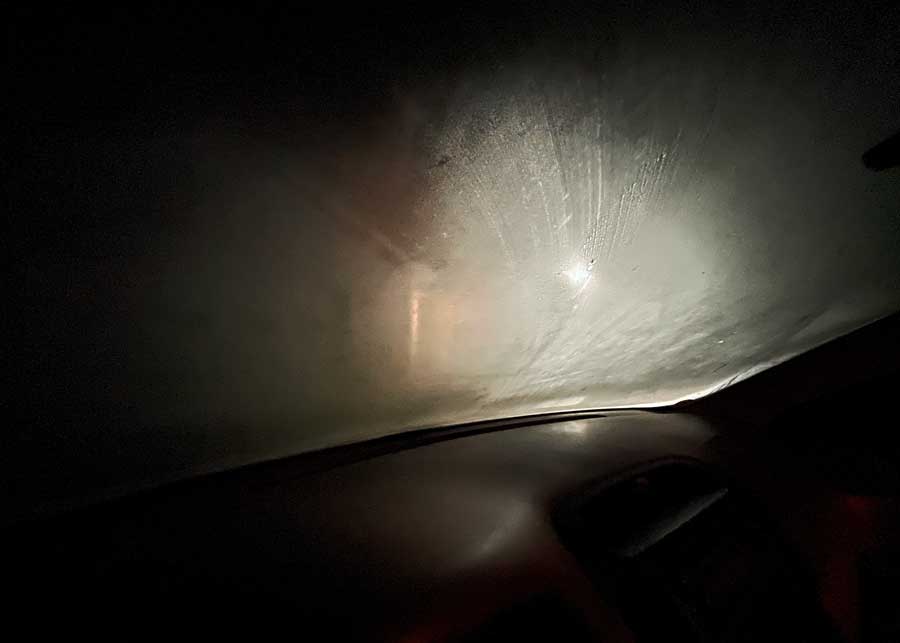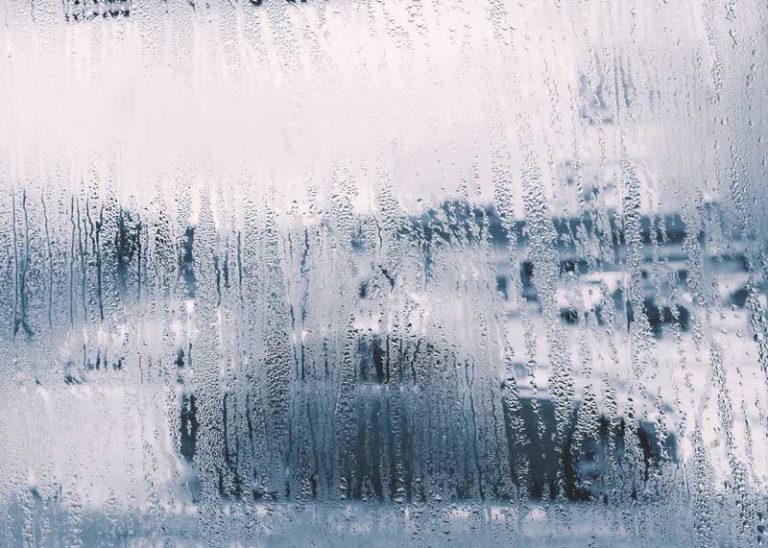How to Defog Windshield in Summer (7 Fixes, 8 Reasons)
Camping in the summer means foggy windshields. Moisture forms inside your vehicle because the temperature and humidity difference between inside and outside. Condensation often comes from breathing and wet clothes inside the RV, fogging up the windshield.
Here’s how to defog your windshield in the summer. Turn your heat and A/C up at the same time. You can also switch to fresh air setting, reduce moisture sources, crack the windows, and apply Rain-X. Clean windows (both sides) also help reduce foggy windshields.

Why is my windshield fogging up in the summer? This can be caused by temperature variances, high humidity, and a wrong ventilation setting. One of the most common reasons your car or RV will have a foggy windshield is because you slept in it. More on this below.
There are numbeous factors affecting your windshield fogging up in the summer.
What Causes Windshield Fog?
Windshield fog is caused by temperature differences and humidity levels. On a cold day, moisture inside the car can condense on the glass inside your car. This happens when the temperature reaches the dew point.
If you’ve ever slept overnight in your car, you’ve likely seen the windows fogged up by morning. And this is equally common in an RV.
Windshields can fog up on both sides: inside and outside.
- Internal fog is the worst, because it’s harder to defog. And it’s very common in an RV. Because of cooking, showers, and sleeping, there is a lot of humidity inside the car.
- Fog formed on the outside of the windshield can usually be easily removed with windshield wipers. In certain conditions, the air conditioner can create condensation on the outside of your windshield.
More on reasons for fogged up windshields below this section.

How to Stop Windshield From Fogging Up
While foggy windshields are annoying, you can quickly solve the problem with a few techniques while driving.
You can prevent your windshield from fogging up with a few easy methods.
1. Use Heat and A/C Simultaneously
A quick trick to stop fogginess on the inside and outside is to turn on both the air conditioning and heat.
Set both to full power and have the heat at the highest setting.
- The heat will help evaporate the condensation that formed.
- And the air conditioner will dehumidfy the air.
The windshield will be the same temperature as the outside air, and the fogginess will dissipate quickly.
This is a great trick to quickly clear your windshield of fog and you need to drive your car right away.
2. Use the Fresh Air Setting
If your windshield starts to fog in the summer, check the air circulation setting.
The fresh air setting will help reduce window fogginess on hot and humid days, even if when the air conditioning runs.
This air circulation button has an image of a car with an arrow pointing to it.
When this button is on, your car uses fresh air in its HVAC system. Pressing this button can help reduce fogginess when the air conditioning is running.
3. Reduce Moisture Sources
There are many sources of moisture that can be inside your RV or car in the summer. Things like wet beach towels and swimsuits, wet laundry, and hot drinks all add humidity to the air.
If your camping in an RV, don’t forget to use the ventilation fan when showering or washing dishes. Boiling water on the stove will add more moisture.

4. Open the Windows
Remember, windshields fog up when one side is cool, and the other is hot and humid. You can create balance by opening your car windows.
Opening the window also allows the moist air to escape. And it helps to normalize the temperature between inside and outside the vehicle.
5. Use Rain-X
Adding a hydrophobic coating to your windshield can help prevent the formation of fog. Rain-X glass treatment is a well-known product that causes water to bead and roll away.
We’ve been using hydrophobic repellents on our GoPro for many years.
6. Apply Shaving Foam to Your Windshield
An alternative to Rain-X is spraying your windshield with shaving foam. It also adds a film to the glass.
Here’s how to do it:
- Spray a golf-ball-size amount of foam into your hand.
- Lather your windshield with the foam, then let it sit for about two minutes.
- Use a clean, dry cloth to remove the foam, and enjoy having a fog-free windshield. The foam makes your windows slippery, so the moisture rolls off the glass.
For the best results avoid using a shaving gel or a product with fragrance, menthol, or extra additives.
Usually, the cheaper brands work best. Clean your windshield on a cloudy day, so the sun doesn’t make the foam dry too quickly.
My preference is Rain-X over shaving cream. It’s a cleaner application. And it was made for that purpose.
7. Keep Your Car Windows Clean
Keeping your windows clean can reduce the chances they fog up. Dirty windows with oil, road debris, and pollen give moisture something to grab.
When your windows are clean, the moisture will still build up, but it will roll down the glass sooner. The less moisture hanging on the glass means you’ll have more visibility.
Windows don’t only fog up in the summer. Here’s how to stop windows from fogging up in winter.

8 Reasons Windshields Fog Up in Summer
Here’s why your RV windshield fogs up in the summer.
1. You Slept in Your Car or RV
Sleeping in your vehicle can cause your windows to fog up in the summer.
How much water do we exhale during breathing? According to a 2012 study, an adult can exhale about 60-70 ml of water per hour. Multiply this by the number of hours spent in your RV or car and you’ll get an idea
Based on this metric, one person can exhale 600 ml of water each night (60 ml per hour x 10 hours). Increase the number of guests in your RV and you could easily introduce a couple of liters of water to interal air, every night.
2. You Have Wet Items in Your Vehicle
High humidity causes windows to fog up.
If you have wet items like beach towels, laundry, or umbrellas in your car and windows are up, the moisture will eventually cause your windows to fog up on the inside.
3. Your Car Interior is Colder than Outside
Condensation builds on windows when the air on one side is warmer. The humid and warm air creates condensation. When the temperature reaches the dew point, your windows fog up.
In the summer, the fogginess occurs outside, especially on humid days when you’re running your air conditioning.
4. You’re Using Air-Recycling Setting
Cars have two air circulation settings. One brings in the fresh air, while the other recycles the air in your vehicle. If you have issues with windshield fogginess, you most likely have your ventilation system on the recirculation setting as it uses the cold air in the car to make more cold air.
The recirculation button has an image of a car with a curved arrow in it. The setting can improve the efficiency of the air conditioning. And using it in the summer keeps pollen and dust outside and makes your air conditioning system work more efficiently.
But the recirculation setting can also cause windshields to fog up inside – especially if you aren’t using the A/C. This is because moisture isn’t leaving the car and it can begin to condense on the glass.
5. You Left The Windows Down
A few nights ago, I went outside to put my car windows up before going to bed. And I was surprised to see that the windshield was fully covered by condensation on the inside.
This doesn’t always happen, but after a hot and humid day, you can get heavy condensation inside the car if the windows are left open as the evening air cools.
6. It’s Raining
High humidity levels outside cause windshields to fog up.
And on warm and rainy days, your windshield can also become foggy on the inside, depending on the internal and external temperatures. And if they are changing.
7. Cold Air Doesn’t Hold Much Moisture
Cold air doesn’t hold as much moisture, so your air-conditioned car interior is dry and cold, compared to the outside air.
The warmth and humidity on the outside meet the chilly windshield and can react by fogging up the window.
8. You Park Your Car Outside
Vehicles parked in a garage won’t have foggy windshields. Park outside and your car windows might fog up on humid nights.
Depending on the weather, the fogginess could be inside of your car, especially if the night was cool and the car interior wasn’t. Foggy car windows are akin to morning dew on the grass.

More reading: How to Get Ice Off Windshield (8 Methods)
Your Turn
What’s working for you to keep your car and RV windows clear of fog this summer? I would love to hear your experience and suggestions.






